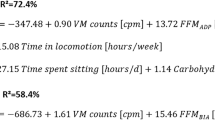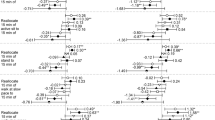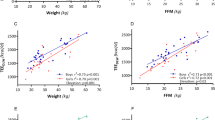Abstract
Background/Objectives:
Energy costs of pregnancy approximate 320 MJ in well-nourished women, but whether or not these costs may be partly covered by modifications in activity behavior is incompletely known. In healthy Swedish women: (1) to evaluate the potential of the Intelligent Device for Energy Expenditure and Physical Activity (IDEEA) to assess energy expenditure during free-living conditions, (2) to assess activity pattern, walking pace and energy metabolism in pregnant women and non-pregnant controls, and (3) to assess the effect on energy expenditure caused by changes in physical activity induced by pregnancy.
Subjects/Methods:
Activity pattern was assessed using the IDEEA in 18 women in gestational week 32 and in 21 non-pregnant women. Activity energy expenditure (AEE) was assessed using IDEEA, as well as using the doubly labelled water method and indirect calorimetry.
Results:
AEE using the IDEEA was correlated with reference estimates in both groups (r=0.4–0.5; P<0.05). Reference AEE was 0.9 MJ/24 h lower in pregnant than in non-pregnant women. Pregnant women spent 92 min/24 h more on sitting, lying, reclining and sleeping (P=0.020), 73 min/24 h less on standing (P=0.037) and 21 min/24 h less on walking and using stairs (P=0.049), and walked at a slower pace (1.1±0.1 m/s versus 1.2±0.1 m/s; P=0.014) than did non-pregnant controls. The selection of less demanding activities and slower walking pace decreased energy costs by 720 kJ/24 h and 80 kJ/24 h, respectively.
Conclusion:
Healthy moderately active Swedish women compensated for the increased energy costs of pregnancy by 0.9 MJ/24 h. The compensation was mainly achieved by selecting less demanding activities.
This is a preview of subscription content, access via your institution
Access options
Subscribe to this journal
Receive 12 print issues and online access
$259.00 per year
only $21.58 per issue
Buy this article
- Purchase on Springer Link
- Instant access to full article PDF
Prices may be subject to local taxes which are calculated during checkout
Similar content being viewed by others
References
Ainsworth BE, Haskell WL, Whitt MC, Irwin ML, Swartz AM, Strath SJ et al. (2000). Compendium of physical activities: an update of activity codes and MET intensities. Med Sci Sports Exerc 32, S498–S504.
American College of Sports Medicine (2006). Guidelines for Exercise Testing and Prescription. Lippincott, Williams, & Wilkins: Baltimore.
Baird J, Fisher D, Lucas P, Kleijnen J, Roberts H, Law C (2005). Being big or growing fast: systematic review of size and growth in infancy and later obesity. BMJ 331, 929.
Banerjee B, Khew KS, Saha N (1971). A comparative study of energy expenditure in some common daily activities of non-pregnant and pregnant Chinese, Malay and Indian women. J Obstet Gynaecol Br Commonw 78, 113–116.
Bexelius C, Lof M, Sandin S, Trolle Lagerros Y, Forsum E, Litton JE (2010). Measures of physical activity using cell phones: validation using criterion methods. J Med Internet Res 12, e2.
Black AE, Prentice AM, Coward WA (1986). Use of food quotients to predict respiratory quotients for the doubly-labelled water method of measuring energy expenditure. Hum Nutr Clin Nutr 40, 381–391.
Blackburn ML, Calloway DH (1974). Energy expenditure of pregnant adolescents. J Am Diet Assoc 65, 24–30.
Butte NF, King JC (2005). Energy requirements during pregnancy and lactation. Public Health Nutr 8, 1010–1027.
Butte NF, Wong WW, Treuth MS, Ellis KJ, O’Brian Smith E (2004). Energy requirements during pregnancy based on total energy expenditure and energy deposition. Am J Clin Nutr 79, 1078–1087.
Coward WA (1988). Stable isotopic methods for measuring energy expenditure. The doubly-labelled-water (2H2(18)O) method: principles and practice. Proc Nutr Soc 47, 209–218.
Food and Nutrition Board and Institute of Medicine (2005). Doubly labeled water to predict energy expenditure. In: Dietary Reference Intakes for Energy, Carbohydrate, Fiber, Fat, Fatty Acids, Cholesterol, Protein and Amino Acids (Macronutrients). The National Academies Press: Washington DC, USA. pp 1104–1202.
Forsum E, Kabir N, Sadurskis A, Westerterp K (1992). Total energy expenditure of healthy Swedish women during pregnancy and lactation. Am J Clin Nutr 56, 334–342.
Hytten FE, Leitch I (1971). The Physiology of Human Pregnancy. Blackwell Scientific Publications: Oxford, United Kingdom.
Institute of Medicine and National Research Council (2009). Consequences of gestational weight gain for the mother. In: Rasmussen K, Yaktine AL (eds). Weight Gain During Pregnancy: Re-examining the Guidelines. The National Academies press: Washington DC, pp 173–194.
International Atomic Energy Agency (2009). Assessment of Body Composition and Total Energy Expenditure in Humans Using Stable Isotope Techniques IAEA Human Health Series No. 3 IAEA: Vienna.
Lof M, Hannestad U, Forsum E (2003). Comparison of commonly used procedures, including the doubly-labelled water technique, in the estimation of total energy expenditure of women with special reference to the significance of body fatness. Br J Nutr 90, 961–968.
Lof M, Forsum E (2006). Activity pattern and energy expenditure due to physical activity before and during pregnancy in healthy Swedish women. Br J Nutr 95, 296–302.
Marsh AP, Vance RM, Frederick TL, Hesselmann SA, Rejeski WJ (2007). Objective assessment of activity in older adults at risk for mobility disability. Med Sci Sports Exerc 39, 1020–1026.
Melzer K, Schutz Y, Boulvain M, Kayser B (2009). Pregnancy-related changes in activity energy expenditure and resting metabolic rate in Switzerland. Eur J Clin Nutr 63, 1185–1191.
Michels K, Xue F (2006). Role of birth weight in the aetiology of breast cancer. Int J Cancer 348, 2007–2025.
National Board of Health and Welfare (2011): http://www.socialstyrelsen.se (accessed 9 June 2011).
Poudevigne MS, O′Connor PJ (2006). A review of physical activity patterns in pregnant women and their relationship to psychological health. Sports Med 36, 19–38.
Prentice AM (1988). Stable isotopic methods for measuring energy expenditure. Applications of the doubly-labelled-water (2H2(18)O) method in free-living adults. Proc Nutr Soc 47, 259–268.
Prentice AM, Spaaij CJ, Goldberg GR, Poppitt SD, van Raaij JM, Totton M et al. (1996). Energy requirements of pregnant and lactating women. Eur J Clin Nutr 50 (Suppl 1), S82–S110.
Robinson R (2001). The fetal origins of adult disease. BMJ 322, 375–376.
Rousham EK, Clarke PE, Gross H (2006). Significant changes in physical activity among pregnant women in the UK as assessed by accelerometry and self-reported activity. Eur J Clin Nutr 60, 393–400.
Saremi K, Marehbian J, Yan X, Regnaux J-P, Elashoff E, Bussel B et al. (2006). Reliability and validity of bilateral thigh and foot accelerometry measures of walking in healthy and hemiparetic subjects. Neurorehabil Neural Repair 20, 297–305.
Scientific Advisory Committee on Nutrition (SACN) (2009). Energy Requirements Working Group Draft Report, November 2009, pp 42–45, 53–54. http://www.sacn.gov.uk (accessed 9 June 2011).
Speakman JR (1998). The history and theory of the doubly labeled water technique. Am J Clin Nutr 68, 932S–938S.
Swedish National Institute of Public Health (2011). Published Statistics for Body Mass Index in Adults in Sweden During 2007–2008. http://www.fhi.se (accessed 9 June 2011).
van Raaij JM, Schonk CM, Vermaat-Miedema SH, Peek ME, Hautvast JG (1990). Energy cost of walking at a fixed pace and self-paced before, during, and after pregnancy. Am J Clin Nutr 51, 158–161.
Weir JB (1949). New methods for calculating metabolic rate with special reference to protein metabolism. J Physiol 109, 1–9.
Welk GJ, McClain JJ, Eisenmann JC, Wickel EE (2007). Field validation of the MTI Actigraph and Bodymedia armband monitor using the IDEEA monitor. Obesity 15, 918–928.
World Health Organization (1985). FAO/WHO/UNU Expert Consultation. Requirements during pregnancy. In: Energy and Protein Requirements. World Health Organization Technical Report Series No. 724. World Health Organization: Geneva.
World Health Organization (2004). Human Energy Requirements Food and Nutrition Technical Report Series. FAO: Rome. pp 53–62.
Zhang K, Werner P, Sun M, Pi-Sunyer FX, Boozer CN (2003). Measurement of human daily physical activity. Obes Res 11, 33–40.
Zhang K, Pi-Sunyer FX, Boozer CN (2004). Improving energy expenditure estimation for physical activity. Med Sci Sports Exerc 36, 883–889.
Acknowledgements
This study was supported by FORMAS, the Magnus Bergvall Foundation, the Thuring Foundation and the Swedish Society of Medicine.
Author information
Authors and Affiliations
Corresponding author
Ethics declarations
Competing interests
The author declares no conflict of interest.
Rights and permissions
About this article
Cite this article
Löf, M. Physical activity pattern and activity energy expenditure in healthy pregnant and non-pregnant Swedish women. Eur J Clin Nutr 65, 1295–1301 (2011). https://doi.org/10.1038/ejcn.2011.129
Received:
Revised:
Accepted:
Published:
Issue Date:
DOI: https://doi.org/10.1038/ejcn.2011.129
Keywords
This article is cited by
-
Factors associated with the level of physical activity in a multi-ethnic pregnant population – a cross-sectional study at the time of diagnosis with gestational diabetes
BMC Pregnancy and Childbirth (2022)
-
Stoffwechsel und Ernährung in der Schwangerschaft
Monatsschrift Kinderheilkunde (2022)
-
MET-values of standardised activities in relation to body fat: studies in pregnant and non-pregnant women
Nutrition & Metabolism (2018)
-
A systematic literature review of reviews on techniques for physical activity measurement in adults: a DEDIPAC study
International Journal of Behavioral Nutrition and Physical Activity (2018)
-
Usefulness of motion sensors to estimate energy expenditure in children and adults: a narrative review of studies using DLW
European Journal of Clinical Nutrition (2017)



